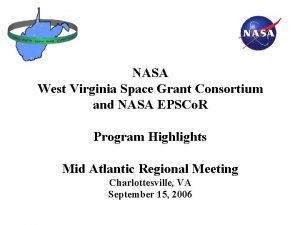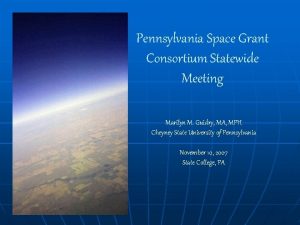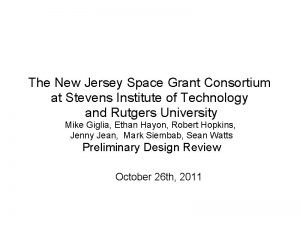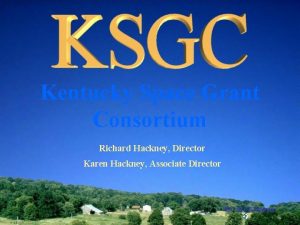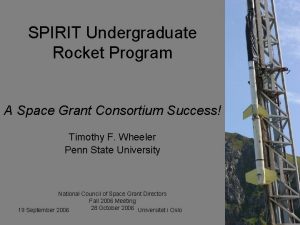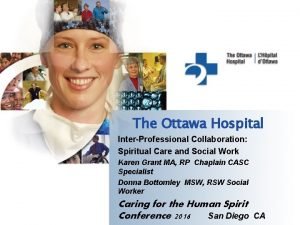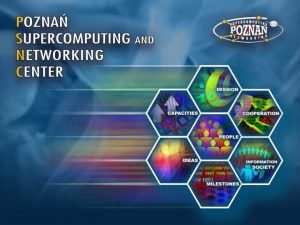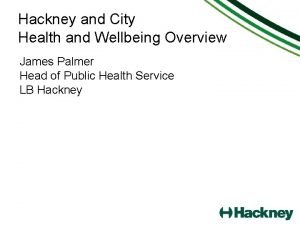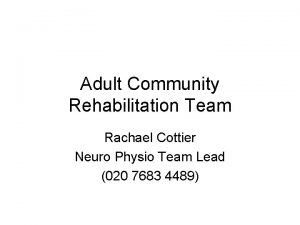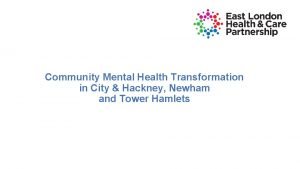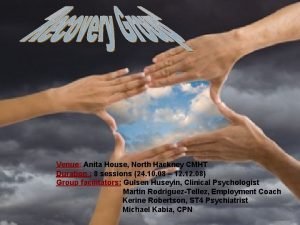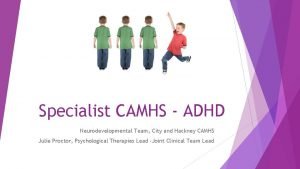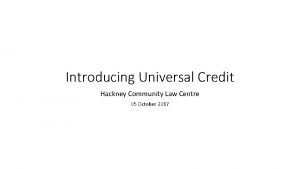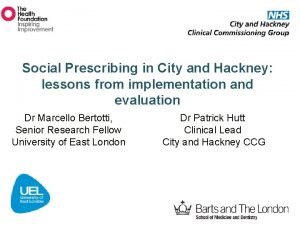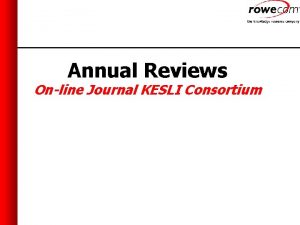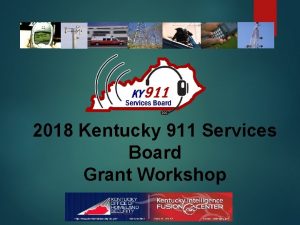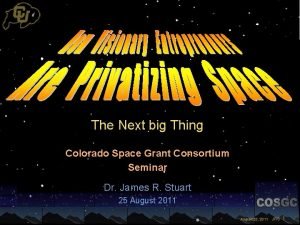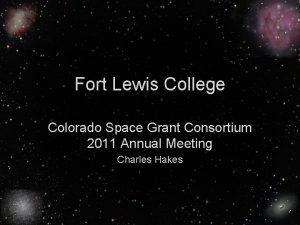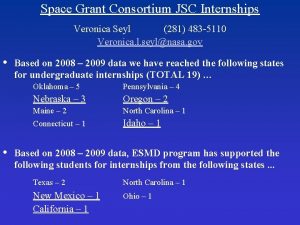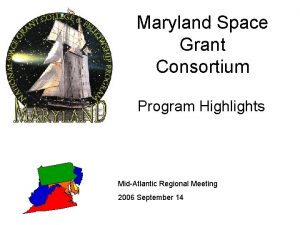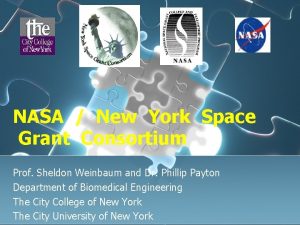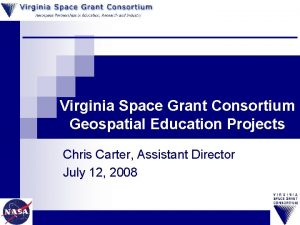Kentucky Space Grant Consortium Richard Hackney Director Karen

















- Slides: 17

Kentucky Space Grant Consortium Richard Hackney, Director Karen Hackney, Associate Director BIG BLUE Program

Kentucky Space Grant Network Bellarmine University Centre College Eastern Kentucky University Ky Center for Space Enterprise Kentucky State University Morehead State University Murray State University Northern Kentucky University Thomas More College Tribo Flow Separations, LLC Transylvania University of Kentucky University of Louisville Western Kentucky University Needs of Kentucky, KSGC Mission, Organizing Principles. . . BIG BLUE Program

The Narrowing STEM Pipeline Early Grades : Nearly everyone likes dinosaurs, space, and science. College Entry : Too few have prepared for higher education STEM studies. Higher Education : Our Roles: Inspire Precollege Students to prepare for STEM majors and careers Too few follow through to supply future STEM needs. Motivate College Students for retention and advanced studies for STEM careers Everything we do contributes to workforce development. . . BIG BLUE Program

Precollege Teachers University faculty conduct workshops to prepare teachers with hands-on activities to inspire active student interest in STEM subjects and possible careers. Content-based workshops incorporate NASA materials/subjects to inspire interest and teach state science education standards Astronomy -- Space Science -- Robotics Aerospace Education Specialists (AESP) Certify teachers to borrow lunar samples If precollege teachers aren’t prepared to inspire students here, not enough students will prepare for STEM higher education. BIG BLUE Program

Public (Parent )Education Maintaining parents’ and students’ interest in science provides support for students’ pursuit of STEM interests and career preparation. NASA topics featured in planetarium presentations and telescope viewing Provide interaction with NASA’s projects and programs ISS Astronauts BIG BLUE Program

Fellowships and Scholarships Motivate retention to graduation in STEM fields Develop workforce skills through mentored research projects Research Aids Retention/ Promotes Advanced Study Involve in NASA Opportunities Presentation of Results NASA Center Visits/ Collaborations NASA Academies and Internships BIG BLUE Program

Faculty/Student Research platforms for student workforce training and experience Research faculty are funded to: • • • Involve students in research Develop connections with NASA researchers Take students for interactions with NASA Centers/researchers Langley Examples: Computational Fluid Dynamics (CFD), Aerodynamic Structures, Airfoil Technology, Inflatable Structures, Unmanned Aerial Vehicles John Baker Vince Capece Steve Cobb George Huang Jamey Jacob Jack Leifer John Main Suzanne Smith BIG BLUE Program

Workforce Development Projects Team-based, interdisciplinary “mission” projects, students working together integrating contributions, having extensive “workforce” experiences. NASA Moonbuggy Competition, Workshops, Regional Competition (Pipeline) NASA Reduced-Gravity Student Flight Experiments 10 teams since 1997 BIG BLUE Program

A High Altitude Inflatable -Winged Aircraft An Original Engineering Challenge: Design a wing that … • • Can fly in the thin air at 100, 000 ft altitude, as on Mars Can be packaged compactly for transportation to Mars Can be inflated to full size when deployed on Mars Can be rigidized to permit flight Deploy and fly it. . . As On Mars On earth, we need a balloon lift to ~100, 000 ft BIG BLUE Program

Workforce Development Project: BIG BLUE Baseline Inflatable Glider Balloon Launched Unmanned Experiment BB II on The History Channel Interdisciplinary project developed by University of Kentucky faculty Complete NASA-Like Missions: Student teams design, build, test, launch, deploy, fly, analyze, and report on a high-altitude glider as a prototype Mars UAV explorer. BB III BIG BLUE Program

Students Consult with Industry and NASA Engineers ILC Dover --Maker of • NASA’s space suits • Pathfinder’s airbags • Big Blue’s inflatable wings CDR Students with prototype wing NASA Center Visits -Consultations with NASA engineers NASA Langley Initial visit NASA Wallops Apollo 17 Lunar Astronaut Harrison Schmitt BIG BLUE Program

From UV-Hardened to Reusable Pressurized Wings 160 students in 3 years, many teams Wings deploy at ~100, 000 ft, as in Mars’ atmosphere Systems Engineering -- Project and Courses Many now employed in aerospace, other technical areas, or pursuing advanced degrees New technology for and by ILC Dover (UAV, SBIR) New faculty/student research areas, grants BIG BLUE Program

Unmanned Aerial Vehicles (UAV) Aerial Robotics Team Systems Engineering: Low speed aerodynamics Vehicle design, performance Flight control Communication Imaging and surveillance Electronic Design Consulting trips to NASA Wallops and MSFC 2005 PAX River UAV Student Competition Testing and Recovery The only 1 st year team, finished 6 th out of 13, over Cornell and MIT. BIG BLUE Program

PAX River UAV 2006 Competition Mission Requirements Takeoff, fly specified waypoints, identify ground targets, return for landing within allotted time. Criteria include dynamic air vehicle control, autonomous flight, GPS navigation, target recognition, adjustment to changing requirements. Only team with two UAVs flying autonomously at the same time. Tougher competition from 18 teams, finished 5 th overall. Our students received several job offers on the spot -- from the judges. 24 students, several now employed in aerospace. One operated the ground station for the first contact with Genesis-1. BIG BLUE Program

Ky. Sat-1 Kentucky’s Satellite Project -- CUBESAT for Low Earth Orbit Multi-Disciplinary, Multi-University Public, Private, Academic Owners Purpose Workforce Development Experience Interest Students in Science and Engineering Attract Industry to Come and Fly with Us Timeline January 06 – Idea from Ames/Stanford/KY Interactions March 06 – Ky. Sat Consortium Formed Summer 06 -- 7 -Student Design Team at Ames/Stanford December 06 – Engineering Model Complete April 07 – Flight Model Complete July 07 – Shipment to Launch-Integrator December 07 – Ready for Launch Garrett Alaa Jen Dale Dan Bill Greg BIG BLUE Program

Ky. Sat-1 Interactive Features Engineering Research Precollege Users (Ground Station Ops) (“Play-Ground” Stations) S-Band Radio Control (2. 4 GHz) Photographs, Downlink Commands, File Transfer Advanced Users Continuous Beacon Audio Playback (ala Suit. Sat) (Universities, Radio Amateurs) Ham freq 144, 440 MHz Inexpensive Handheld Ground Digital Beacon/Repeater Stations Loaned to Schools: APRS Data Standard Students interact with Ky. Sat via Possible Audio Repeater ham radio (license), after studying curriculum about space, satellites, orbits, applications Morehead State University 21 - meter Tracking Antenna Ground Ops Curriculum, Audio Telemetry 24 incoming students (ala Suit. Sat) Incubator Companies BIG BLUE Program

Workforce Development From America’s Widely Distributed Talent Pool The wind beneath America’s wings. . . BIG BLUE Program
 Wisconsin space grant consortium
Wisconsin space grant consortium Pa space grant
Pa space grant New jersey space grant consortium
New jersey space grant consortium Richard hackney
Richard hackney Wisconsin space grant consortium
Wisconsin space grant consortium Karen grant
Karen grant Junos space connectivity services director spec
Junos space connectivity services director spec Hackney population density
Hackney population density Acrt hackney
Acrt hackney City and hackney recovery college
City and hackney recovery college North hackney cmht
North hackney cmht Hackney adhd clinic
Hackney adhd clinic What are the 5 stages of the counseling process
What are the 5 stages of the counseling process Paradoc hackney
Paradoc hackney Hackney community law centre
Hackney community law centre Social prescribing hackney
Social prescribing hackney Hackney autism service
Hackney autism service Richard iii and looking for richard
Richard iii and looking for richard
